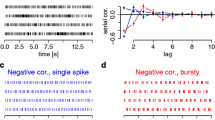Abstract.
We propose a new method of studying the correlation between neuronal spike trains. This technique is based on the analysis of relative phase between two point processes. Relative phase here is defined as the relative timing difference between two spike trains normalized by the associated interspike interval of one cell. This phase measurement is intended to reveal the relative timing relationship between spike trains atdifferent firing rates. We apply this method to a numerical example and an example from two cerebellar neuronal spike trains of a behaving rat. The results are compared with classical cross-correlation analysis. We show that the technique can avoid some of the limitations of cross-correlation methods, reveal certain statistical dependencies that cannot be shown by cross correlation, and provide information as to the direction of influence between two spike trains.
Similar content being viewed by others
Author information
Authors and Affiliations
Additional information
Received: 8 November 2001 / Accepted: 30 September 2002 / Published online: 24 January 2003
Correspondence to: Y. Chen (e-mail: chen@nsi.edu, Fax: + 1-858-626-2099)
Acknowledgements. Research for this paper was supported by the Alafi Family Foundation and the Neurosciences Research Foundation.
Rights and permissions
About this article
Cite this article
Chen, Y., Nitz, D. Use of `relative-phase' analysis to assess correlation between neuronal spike trains. Biol. Cybern. 88, 177–182 (2003). https://doi.org/10.1007/s00422-002-0367-5
Issue Date:
DOI: https://doi.org/10.1007/s00422-002-0367-5




